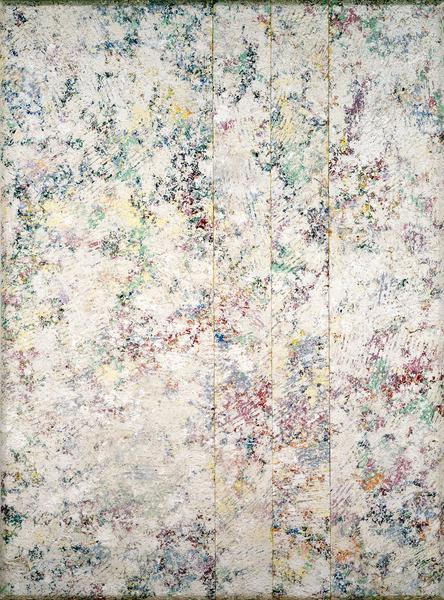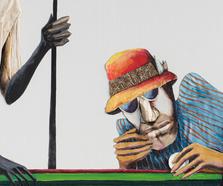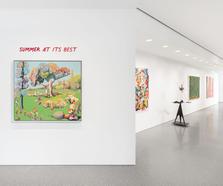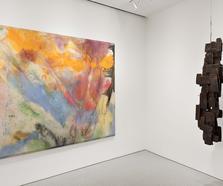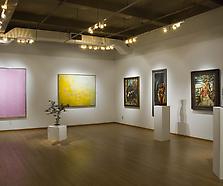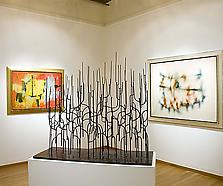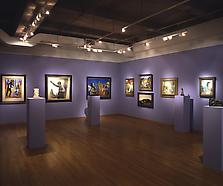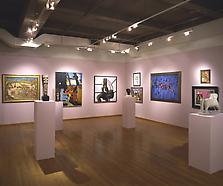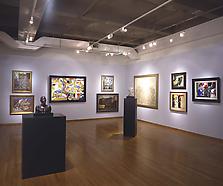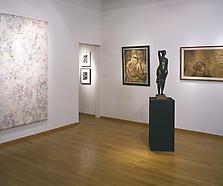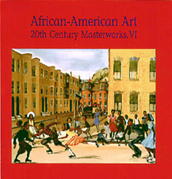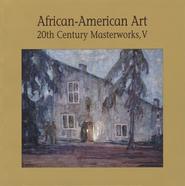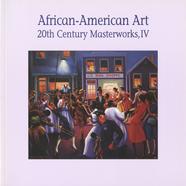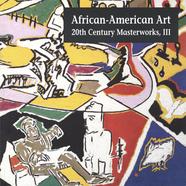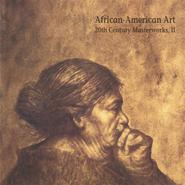“My work consists of solids and veils: the union of solids, or metal forms, seen as volumes against a raked and grooved paint surface. It is constructed painting, in that it crosses the void between object and viewer, to be part of the space in front of the picture plane. It represents an act of pure passage. The surface is no longer the final plane of the work. It is instead the beginning of an advance into the theater of life.”[1]
Internationally recognized as one of the foremost contemporary color field painters, Sam Gilliam was born in Tupelo, Mississippi, the seventh of eight children. Soon after his birth, Gilliam’s father, a railroad worker, and his mother, a school teacher, moved the family to Louisville, Kentucky. Gilliam grew up in a structured, Baptist home, “No smoking, no drinking, no card playing, no going to basketball games. Everybody came home at 9:00 and you spent all day Sunday in church.”[2] Gilliam began painting as a child and participated in a special arts program at his junior high school. After high school, he attended the University of Louisville, where he studied art with the German-born painter Ulfert Wilke. Gilliam received his BFA in 1955 and entered graduate school, but had to put his studies on hold while he served in the army for two years, spending most of that time in Japan. Upon completion of his service in 1958, he resumed his studies at the University of Louisville and received his MFA in 1961. He taught in the Louisville public education system for a year and then moved to Washington, DC.
In Washington, Gilliam befriended Thomas Downing and became part of the Washington Color School, moving away from his earlier style of dark figural abstraction towards the production of large works with fields of flatly applied color. Influenced by abstract expressionism, Gilliam experimented with methods of applying pigment, often pouring paint, staining canvases, and folding them while still wet. His fascination with the flexibility of canvas led to the revelation that “the canvas was not only the means to, but a primary part of, the object.”[3] Gilliam’s conviction that painting could be three-dimensional led him to innovate with draping and suspending canvases; in 1965 he became the first painter to introduce the unsupported canvas. Just as he altered the terms on which painting and sculpture could be seen in relation to one another, Gilliam, like Norman Lewis, Alma Thomas, Richard Hunt, and other contemporaries working in abstraction, sought alternative ways to be a community-oriented artist engaged in politics. Although his art was not usually explicitly political, titles such as Jail Jungle (1968-1974) and Dark as I Am (1971-1972) allude to the realities of racial inequality in the United States. Furthermore, like his peers, Gilliam participated in demonstrations and acts of civil disobedience.
In 1970, Gilliam resumed painting on stretched canvases, applying the paint in ways that added dimensionality and texture to the surface. By the middle of the decade, though, he again sought means to trouble the boundaries between painting and sculpture, which led him to invent “a beveled stretcher with the forward edges chamfered, resulting in a frame made by canvas that extended beyond the painting itself, increasing its dimensions. Subsequently, these stretchers gave the paintings a slab-like concreteness consistent with the heavier painting [he] was making then.”[4] Gilliam continued to push the boundaries of painting, creating public works that introduced new materials into his art, geometric collages influenced by jazz, a series of “quilted” paintings, and textured paintings that incorporate metal forms. In 1990, Gilliam worked with Tandem Press and its founder, William "Bill" Weege, to create a 4,500-foot long print titled Fireflies and Ferriswheels that traveled to various museums throughout the world.
Gilliam’s work as an artist and teacher and his bold commitment to creating painting with sculptural, architectural, and textile properties has made him an influential presence in modern art. He lives and continues to works in Washington, DC. In 2005, the Corcoran Gallery of Art organized the first traveling, full-scale survey of his artwork, Sam Gilliam: A Retrospective. In 2017, a solo exhibition was held at the Seattle Art Museum, Seattle, WA and he was featured in VIVA ARTE VIVA, curated by Christine Macel, at the 57th Venice Biennale in Venice, Italy. In 2018, Gilliam was the subject of the major exhibition The Music of Color: Sam Gilliam, 1967-1973 at the Kunstmuseum Basel in Switzerland, curated by Jonathan Binstock and Dr. Josef Helfenstein; and in 2019, an exhibition of Gilliam’s early work opened on long-term view at Dia:Beacon, New York.
Recent group exhibitions featuring work by Gilliam include Visual Art and the American Experience, National Museum of African American History and Culture, Smithsonian Institution, Washington, DC (2016); Circa 1970, The Studio Museum in Harlem, New York, NY (2016); Art of Rebellion: Black Art of the Civil Rights Movement, Detroit Institute of Arts, Detroit, MI (2017); Pattern, Decoration and Crime, Musée d'art moderne et contemporain, Geneva (2018); Expanding Narratives: The Figure and the Ground, Smart Museum of Art, The University of Chicago, Chicago, IL (2018); and Spilling Over: Painting Color in the 1960s, Whitney Museum of American Art, New York (2019). Gilliam’s work was recently included in the major traveling exhibition Soul of a Nation: Art in the Age of Black Power, organized by Tate Modern, London (2017-2020) as well as Black Refractions: Highlights from The Studio Museum in Harlem, most recently on view at Utah Museum of Fine Arts, Salt Lake City (2021).
Sam Gilliam is represented in numerous museum collections including The Menil Collection (Houston, TX); Pennsylvania Academy of the Fine Arts (Philadelphia); The Museum of Modern Art (New York); Whitney Museum of American Art (New York); Smithsonian American Art Museum (Washington, DC); the Metropolitan Museum of Art (New York); Seattle Art Museum (WA); Crystal Bridges Museum of American Art (Bentonville, AR); Kunstmuseum Basel (Switzerland); Virginia Museum of Fine Arts (Richmond); and the Chrysler Museum of American Art (Norfolk, VA).
[1] Sam Gilliam, with Annie Gawlak, “Solids and Veils,” Art Journal, 50:1 (Spring, 1991), 10.
[2] Sam Gilliam, quoted in Eric S. McCready, “Tanner and Gilliam: Two American Black Painters,” Negro American Literature Forum, 8:4 (Winter, 1974), 280. Originally quoted in “The Art of Survival (and vice versa),” New York Times (Feb. 17, 1974), 51.
[3] Gilliam, “Solids and Veils,” 10.
[4] Gilliam, “Solids and Veils,” 10.
SELECTED MUSEUM COLLECTIONS
Art Gallery of Nova Scotia, Canada
Art Institute of Chicago, IL
Art Museum, Princeton University, NJ
Baltimore Museum of Art, MD
Beymans Museum, Rotterdam, The Netherlands
Brooks Museum, Memphis, TN
Cincinnati Art Museum, OH
Corcoran Gallery of Art, Washington, D.C.
Crocker Art Museum, Sacramento, CA
Dayton Art Institute, OH
Denver Art Museum, CO
Detroit Institute of Art, MI
Elvehjm Museum of Art, Madison, WI
High Museum, Atlanta, GA
Hirshhorn Museum and Sculpture Garden, Washington, D.C.
Indianapolis Museum of Art, IN
James E. Lewis Museum of Art, Morgan State University, Baltimore, MD
Madison Art Center, Madison, WI
Menil Collection, Houston, TX
Metropolitan Museum of Art, New York, NY
Milwaukee Art Museum, WI
Musee d’Art Moderne, Paris, France
Museum of African Art, Washington, D.C.
Museum of Art, Carnegie Institute, Pittsburg, PA
Museum of Art, Fort Lauderdale, FL
Museum of Contemporary Art,Chicago, IL
Museum of Fine Arts, Boston, MA
Museum of Modern Art, New York, NY
National Collection of Fine Arts, Smithsonian Institution, Washington, D.C.
National Museum of American Art, Washington, D.C.
National Museum of Jamaica, Kingston
New Jersey State Museum, Trenton, NJ
Oberlin College, OH
Oklahoma Art Center, Oklahoma City, OK
Philadelphia Museum of Art, PA
Phipps Collection, Washington, D.C.
J.B. Speed Art Museum, Louisville, KY
Szepmuveszeti Museum, Budapest, Hungary
Tate Gallery, London, Enland
University of Iowa, Iowa City, IA
Virginia Museum of Fine Art, Richmond,VA
Walker Art Center, Minneapolis, MN
Whitney Museum of American Art, New York, NY
Woodward Foundation, Washington, D.C.


